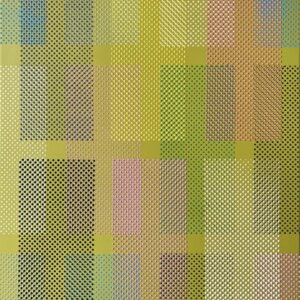One to Watch
 Jürgen Katzenberger: Color and Shape
Jürgen Katzenberger: Color and Shape
German painter Jürgen Katzenberger’s geometric and abstract works are influenced by the artist’s background in fashion and graphic design. Utilizing the pointillism technique, Jürgen creates finely detailed, bright, and refined minimalist works. Keep reading to learn more about Jürgen’s artistic practice and influences.
Tell us about who you are and what you do. What’s your background?
My name is Jürgen Katzenberger and I work as an artist, graphic designer, and illustrator in Munich, Germany––more precisely in Bavaria. I studied fashion and graphic design at the Master School for Fashion in Munich. In the first years, my studies were strongly academic and included artistic subjects such as nude drawing, color and composition theory, and art history. That was food for my artistic soul. It wasn’t until 2015 that I rented a studio in Munich, together with the Chinese artist Wang Yani. She encouraged me to create large-format works of art. After the first sales and exhibitions, I found my true calling. Even as a child, I wanted to be an artist. When I work with colors, I simply experience one of the greatest feelings of happiness.
What does your work aim to say? What are the major themes you pursue in your work?
As an artist, I experiment with new techniques, materials, and concepts to push the boundaries of art. Aesthetics, color, and composition heavily influence my work. I aim to create a space within a space on the canvas. Sometimes this is purely graphic, while in other works flora, fauna, and nature are depicted stylized or abstractedly. I achieve the desired effects by superimposing surfaces or applying three-dimensional paint. One challenge is that photography cannot capture the vivid effect of my works. In my most recent work, “Upwards,” for example, it is difficult to distinguish whether it is a simple print or whether a machine created the work. I simply celebrate form, color, and technique and hope that the joy of my work reaches my customers.
Can you walk us through your process for creating a work from beginning to end?
I discovered my technique about eight years ago through experimentation, which I then developed and refined. I start with an idea in my head, which is then implemented on the computer to simulate motifs or patterns. Now, I decide whether the result is good enough to turn into art. Covering the stretcher frame with raw cotton fabric and then priming it is part of the process of creating my paintings. At the moment, I like to use colorless primed raw linen to integrate the natural fabric color into the motif. The colors I choose for each motif depend on the effect and mood I want to achieve.
Who are your biggest influences, and why?
My main influences are undoubtedly Pop Art, Op Art, and contemporary artists. Thanks to my studies in graphic and fashion design, these influences are also reflected in my work. Perhaps I will work a little more freely again in the future and combine different techniques, similar to what I did with “Summer Peaches” or “Copperblue.”
How does your work comment on current social and political issues?
Art offers an excellent platform for dealing with social and political issues, which I incorporate into some of my works. These works have been very well received at exhibitions. For example, I address the contrast between democracy and dictatorship or the pitfalls of bureaucratic hurdles and small print in texts. A work entitled “Digital Versus Analogue” is currently on show at Saatchi Art. In this work, I illustrate how binary writing is pushing analog technology into the background, raising the question of how we will communicate in the future and what means will be used to do so.
How do you hope viewers respond to your works? What do you want them to feel?
Through direct contact with customers in my store studio, I experience their reactions to my work first-hand. Some of them already know my work via Instagram, but the “wow” effect that the original images trigger in the viewer is exactly what I want to achieve. Of course, there are also visitors whose reaction to my technique is a challenge. But this reaction also fills me with joy because it is a sign of commitment. I prefer such reactions to none at all. Artworks that evoke neither positive nor negative emotions are simply glossed over.
If you could only have one piece of art in your life, what would it be?
A drawing by Egon Schiele. This has nothing to do with the material value, but his drawing style has fascinated me since my student days. If I had the choice, I would choose “Self-Portrait with Hands on Chest.”
If you couldn’t be an artist, what would you do instead?
It would definitely have to be another creative profession or craft. Working with materials with a tactile quality, a smell, or a sound, and the satisfaction at the end of the day when I have created something visible is incomparable. It is a wonderful feeling that is very similar to painting.











